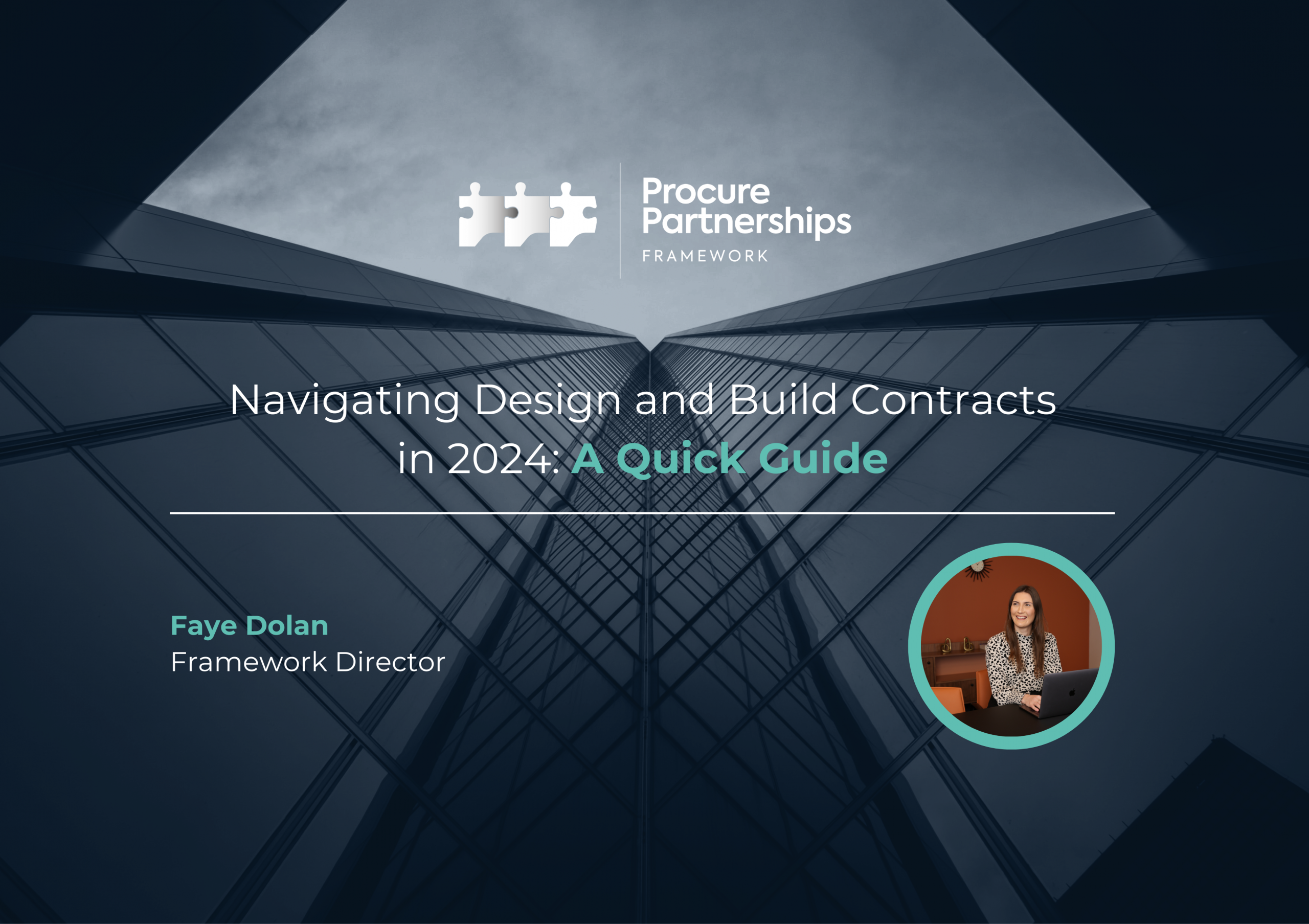Design and Build procurement has gained immense popularity for its ability to integrate design and construction seamlessly, offering clients a single point of responsibility and a guaranteed maximum price.
In this blog post, Faye Dolan, the Director of Procure Partnerships Framework, explores the nuances of novation, sheds light on options within novation, and discusses the influence of the Building Safety Act on design and build projects.
Options of Novation: A Closer Look
Novating the design team is a pivotal decision in the Design and Build contract. The employer’s choice in novation can take different forms. One option is formal novation, where the contractor assumes full responsibility for the design team, managing the remaining design process with the existing team. Alternatively, clients can retain a designer as a ‘technical advisor’ to scrutinize the work of the contractor’s chosen designer. This collaboration ensures a dual-check mechanism, enhancing the overall quality of the project. The flexibility also exists for the contractor and the design team to function as a unified entity, fostering a cohesive and streamlined approach.
Building Safety Act: A Regulatory Influence
The Building Safety Act adds a layer of consideration for clients engaging in Design and Build contracts. If a meaningful start on-site has not occurred before April 6, 2024, the current design may need adjustment. This regulatory aspect emphasizes the importance of timely initiation and completion of projects under the Design and Build umbrella.
The Core Advantages of Novation: A Recap
Novation stands as a cornerstone in the Design and Build process, offering a range of advantages that elevate the efficiency and success of projects. Let’s delve deeper into each advantage, providing insights and examples that illuminate the transformative impact of novation.
-
Reduced Learning Curve: Continuity in Expertise
Novation’s ability to carry forward the expertise of the design team is a game-changer in the construction landscape. Consider a scenario where a healthcare project requires specialized knowledge of patient-centric design, wayfinding, and complex technological requirements. If a specialist architect is engaged from the project’s inception and novated, their accumulated knowledge becomes an invaluable asset. This continuity ensures that the unique intricacies and challenges of the project are seamlessly carried forward, minimizing the time it takes for the contractor to familiarize themselves with the project specifics.
-
Reduced Contractual Risk: Streamlining Responsibilities
The transfer of responsibility to the contractor not only simplifies the process but also mitigates contractual risks for the employer. Picture a situation where a design error surfaces during the construction phase. In a novated Design and Build contract, the contractor assumes responsibility for resolving the issue, avoiding potential legal complexities and disputes. This streamlined approach allows the employer to focus on project progress rather than navigating contractual intricacies with multiple entities.
-
Early Design Improves Cost Certainty: A Strategic Investment
Novation’s impact on early design stages significantly enhances cost certainty, a crucial factor in the success of Design and Build projects. Let’s take the example of a commercial development where detailed initial requirements are translated into a comprehensive design. Novation provides the architect with the assurance of continued engagement, fostering the development of a more refined and detailed design. This early clarity translates into better cost estimates during the tender stage, offering the client a more accurate understanding of the project’s financial landscape.
-
Greater Influence and Control: Collaborative Empowerment
Novation acts as a catalyst in reducing conflicts between the contractor and the design team, promoting a collaborative and empowered approach. Imagine a traditional contract scenario where a defect arises, and the blame game ensues between the contractor and the design team. Novation eliminates this by placing the responsibility squarely on the contractor, who has actively participated in the design process. This collaboration ensures that design decisions are well-aligned with construction goals, and the contractor is better equipped to manage and control the quality risk at each stage.
Disadvantages and Mitigation: A Blueprint for Success
While novation offers a spectrum of advantages, its success hinges on fostering strong relationships. To mitigate potential disagreements, imagine a novated project where the contractor and architect operate in silos, each prioritizing different aspects. The risk of misalignment increases. However, by fostering a culture of honesty and transparency, the potential for conflicts diminishes. Effective communication becomes the cornerstone of a successful novation, where regular updates, joint problem-solving sessions, and open discussions mitigate misunderstandings and strengthen the collaborative bond.
Navigating the Design and Build Landscape in 2024
In conclusion, Design and Build contracts, when executed with strategic novation choices and a keen understanding of regulatory influences, offer clients a pathway to streamlined projects, reduced risks, and enhanced control.
To tackle cost and program challenges in 2024 as the Building Safety Act approaches, framework users can opt for a strategic approach: to appoint the contractor through the Procure Partnerships Framework. In this scenario, the contractor subsequently appoints the design team. This method not only transfers risks in the design phase from the client to the contractor but also enhances control through our extensive reporting capabilities. We use Compliance Chain, a project management software, to performance manage our contractor partners, measuring pre-construction activities to ensure they adhere to the design progression plan. This additional layer of oversight provides clients with enhanced control over the entire process.
The Procure Partnerships Framework, with its emphasis on transparency and support, stands out as a valuable ally in ensuring the success of novated Design and Build contracts. As the industry evolves, staying informed and adapting procurement strategies will be key to unlocking the full potential of Design and Build projects.

Faye Dolan, an esteemed professional and Framework Director at Procure Partnerships, boasts a rich and diverse career spanning seven years in the construction industry. Faye’s journey within Procure Partnerships began in 2018 as a Key Account Manager, initially overseeing the North West region and later extending her purview to the entire North.



